It's hard to talk about traditional Brazilian food as one entity: ours is a rich and diverse cuisine that reflects the country's vast territory and multicultural heritage.
It is heavily influenced by Portuguese colonization, African slaves, indigenous peoples, and immigrants from Europe, South America, and Asia.
However they arrived here, these peoples brought with them their culinary traditions that became the classic dishes of Brazilian cuisine.
The result is a unique blend of flavors, ingredients, and cooking techniques, making Brazilian cuisine world-famous.
Ok, it's a big blend of different cuisines, but where exactly does Brazilian traditional food hail from?
The roots of traditional Brazilian food can be traced back to the indigenous peoples who inhabited the country long before the arrival of the Europeans.
In fact, we have a saying in Brazil: whatever you plant here grows ("Nessa terra, o que se planta, dá.")
When the Portuguese arrived in Brazil in the 16th century, they brought with them their culinary tradition. Although nowadays we tend to think that "feijoada" is a typically Brazilian dish, it actually originated with the Portuguese.
African slaves were also trafficked to Brazil from the XVI to the XIX centuries. Despite all efforts of their captors to make them forfeit all their traditions, slaves brought with them and kept their own culinary traditions, which included dishes such as (my favorite) acarajé, a fried bean fritter we'll discuss in a moment.
Over time, Brazilian cuisine continued to evolve and adapt to the country's changing demographics. Immigrants from Europe, South America, and Asia brought with them their own gastronomic customs, which were integrated into Brazilian cuisine, resulting in a rich and diverse culinary landscape.
In the following sections, we'll look into some of the most famous Brazilian dishes.
Popular Traditional Brazilian Dishes
Feijoada is perhaps the most famous traditional Brazilian dish. It is a hearty stew made with black beans, pork, and beef, and is often served with rice, farofa (toasted cassava flour), and orange slices.
It's something many of my students mention when we start discussing food (along with pão de queijo, but each for different reasons). But it doesn't need to be all you know.
Other popular traditional Brazilian dishes include:
- Farofa: A toasted cassava flour mixture that is often served with feijoada or other stews. Farofa's so versatile that it goes with anything, really.
- Moqueca de camarão: A shrimp stew made with coconut milk, palm oil, and spices. However, if you are allergic, there are versions made with eggs, and vegan options as well.
- Vatapá: The traditional vatapá is a creamy shrimp and peanut stew made with dendê oil and coconut milk. That's the recipe you'll find in Salvador, for example. In Ceará, we use chicken instead of shrimp; instead of peanuts, we use bread.
- Acarajé: A fried bean fritter filled with shrimp, vatapá, and hot sauce.
- Pastel: A fried pastry filled with cheese, meat, vegetables, or anything, really, even "wind".
- Empadão: A savory pie filled with chicken or beef, vegetables, and olives.
- Bolinho de bacalhau: A fried codfish ball.
- Pão de queijo: a small, baked cheese roll made mainly from tapioca flour and cheese.
- Picanha: A beef cut popular for its tenderness and flavor.
- Brigadeiro: A chocolate truffle made with condensed milk and cocoa powder.
- Canjica: A sweet porridge made with corn, coconut milk, and cinnamon.
All of the above food is easy to find depending on the region you live or go to. Some, like canjica, tend to be served more frequently during specific Brazil's public holidays. Others, like "pastel de queijo" (cheese pastel), are served on special occasions and in places such as bars and restaurants as appetizers (what Brazilians call "tira-gosto").
As I said, you'll find different food depending on the region. And there are many...
Regional variations of traditional Brazilian food.
Brazil is ginormous. As a Brazilian who moved quite a bit inside the same region, I can't even begin to understand all differences in cuisine from city to city. Let alone from region to region. Each region has its own unique culinary traditions, ingredients, and flavors.
Below we'll discuss some of the most common dishes in different regions of the country.
Northern Brazil
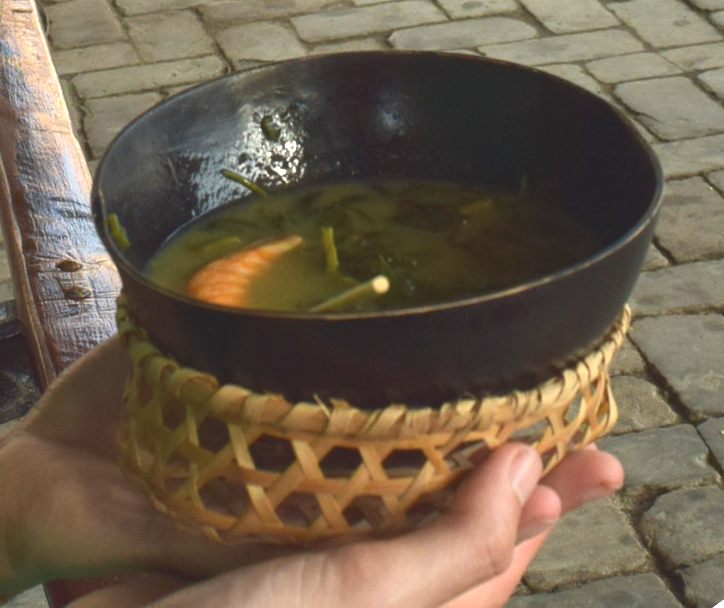
Tacacá - Por Foreade - Obra do próprio, CC BY-SA 4.0, https://commons.wikimedia.org/w/index.php?curid=50772798
Northern Brazilian cuisine is heavily influenced by the indigenous peoples who have inhabited the region for thousands of years.
Their cuisine is characterized by the use of local ingredients such as cassava (mandioca), fish, and fruits like açaí.
Some popular dishes from the region include:
- Tacacá: A soup made with jambu leaves, tucupi broth, and shrimp.
- Maniçoba: A stew made with cassava leaves, pork, and beans.
- Pato no tucupi: A duck stew made with tucupi broth, jambu leaves, and rice.
Northeastern Brazil (where I'm from and live)
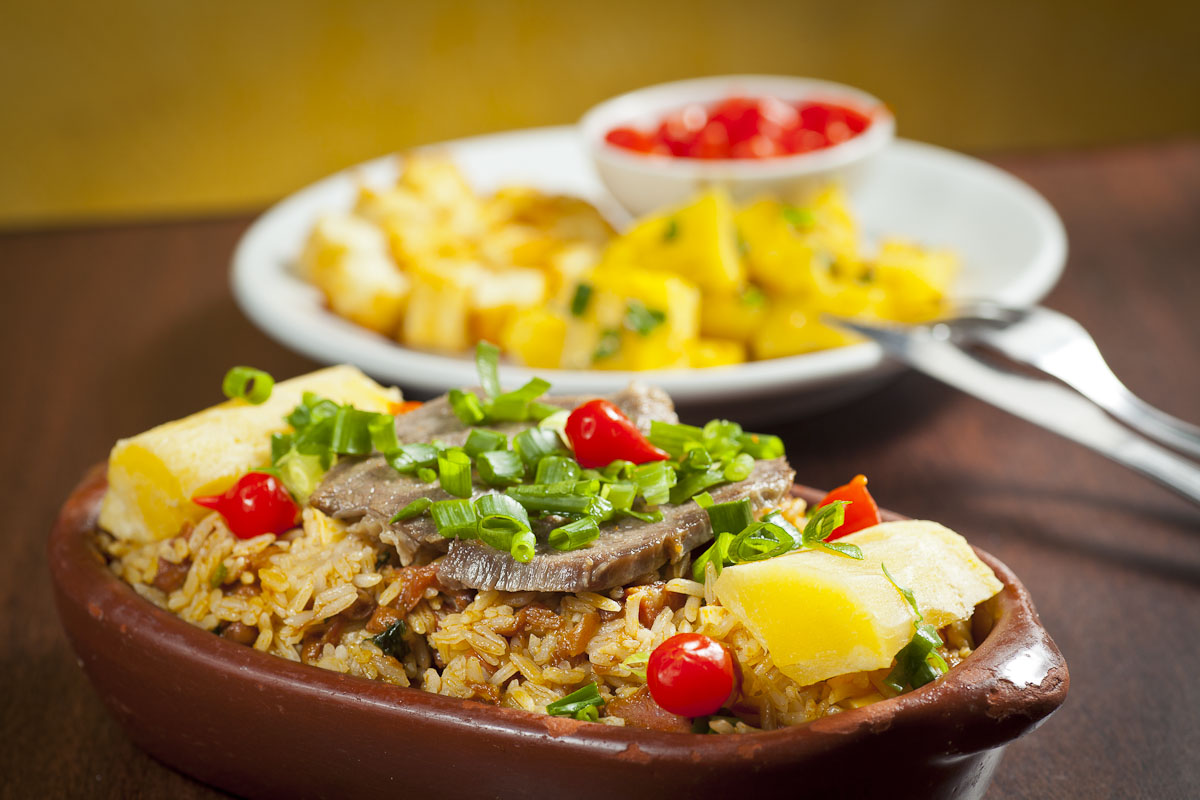
Baião de dois - Por Zé Carlos Barretta - https://www.flickr.com/photos/zebarretta_stock/11174497586/, CC BY 2.0, https://commons.wikimedia.org/w/index.php?curid=38019917
Northeastern Brazilian cuisine is heavily influenced by African and indigenous cultures.
Our cuisine is characterized by the use of seafood, coconut, and palm oil. Some popular dishes from the region include:
- Baião de dois: A rice and bean dish that is often served with grilled meat or fried eggs.
- Carne de sol: A type of beef that is salted and dried in the sun.
- Moqueca de peixe: A fish stew made with coconut milk, dendê oil, and peppers.
Central-Western Brazil
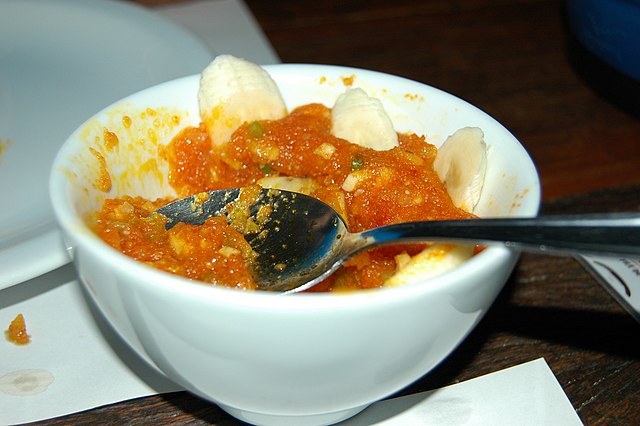
Pirão - De Monica Kaneko - Pirao com bananaUploaded by Diádoco, CC BY-SA 2.0, https://commons.wikimedia.org/w/index.php?curid=11680928
Central-Western Brazilian cuisine is heavily influenced by the country's "cowboy" culture—and I'm saying cowboy for want of a better term for "sertanejo." Their cuisine is characterized by the use of grilled meats and hearty stews. Some popular dishes from the region include:
- Churrasco: A style of grilling meat that is popular throughout Brazil.
- Arroz com pequi: A rice dish made with pequi fruit, which has a distinct flavor I can't even begin to describe.
- Pirão: A thick gravy made from cooked meat and cassava flour juices. It can also be made with the juices of cooked fish, but in that case we describe it as "pirão de peixe" to make it clear.
Southeastern Brazil
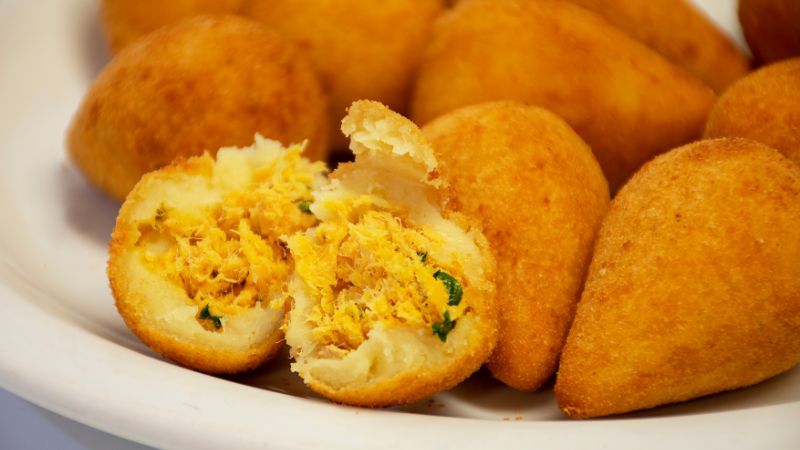
Southeastern Brazilian cuisine is heavily influenced by Portuguese and Italian cultures. The cuisine is characterized by the use of seafood, dairy products, and pasta. Some popular dishes from the region include:
- Feijoada: A stew made with black beans, pork, and beef, which is often considered the national dish of Brazil.
- Pizza: I'm told that the pizza from São Paulo is one of the best in the country. In fact, three of São Paulo pizzerias rank among the 100 best pizzerias in the world [in PT]! Unfortunately, I can't tell from personal experience.
- Coxinha: A fried pastry filled with shredded chicken.
Southern Brazil
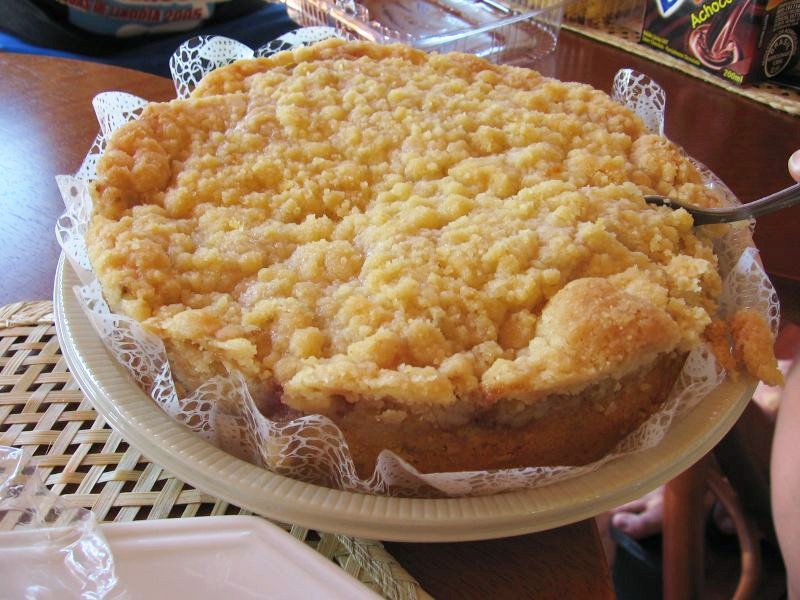
Cuca - Por Ricardo Yasuda - https://www.flickr.com/photos/shadow11/64225343/, CC BY 2.0, https://commons.wikimedia.org/w/index.php?curid=90881133
Southern Brazilian cuisine is heavily influenced by German and Italian cultures. There’s even a city known as Little Germany. The cuisine is characterized by the use of grilled meats, dairy products, and pasta. Some popular dishes from the region include:
- Churrasco: A style of grilling meat that is popular throughout Brazil.
- Barreado: A stew made with beef, bacon, and cassava flour.
- Cuca: A type of coffee cake filled with fruit and streusel topping. Its name comes from the German for cake, "Kuchen".
Each region of Brazil has its own unique culinary traditions, ingredients, and flavors. Exploring the diverse regional variations of traditional Brazilian food is a must for any food lover visiting the country.
But if you don't have the opportunity to go to all five Brazilian regions to try all authentic Brazilian recipes prepared there, there are some...
Popular traditional Brazilian food you should know...
If you really want to understand our culture well.
And here are some of the most popular traditional Brazilian dishes:
Feijoada
Feijoada is often considered Brazil's national dish (alongside with "churrasco"). It is a stew made with black beans, pork, and beef, and it is typically served with rice, farofa, and, in the most traditional ones, orange slices. The origins of the current version can be traced back to the time of slavery when slaves were given the undesirable parts of the pig to eat. They'd use those parts to make themselves a stew, which became our feijoada.
Pão de queijo
Pão de queijo, which means "cheese bread" in Portuguese, is a popular snack throughout Brazil. It is made with tapioca flour, eggs, milk, and cheese, and it has a chewy texture and a cheesy flavor. It is often served for breakfast or as an appetizer, and it's usually associated with the state of Minas Gerais.
Coxinha
Coxinha is a fried pastry traditionally filled with shredded chicken. It has a teardrop shape and is often served as a snack or appetizer. It is believed to have originated in the state of São Paulo and is now popular throughout Brazil.
Brigadeiro
Brigadeiro is a famous Brazilian dessert made with condensed milk, cocoa powder, and butter. It is rolled into small balls and coated in chocolate sprinkles. It is often served at birthday parties and other celebrations.
Churrasco
Churrasco is a style of grilling meat that is popular throughout Brazil. It typically involves skewered meat that is cooked over an open flame. The meat is often seasoned with rock salt and served with farofa, making it a great dish to be served at family gatherings.
Caipirinha
Caipirinha is a cocktail made with cachaça (a Brazilian spirit made from sugarcane you can learn morea about in this article), lime, sugar, and ice. It is the national drink of Brazil and is often served at parties and celebrations.
These are just a few examples of the many delicious traditional Brazilian dishes. Whether you are a meat lover or a vegetarian, there is something for everyone to enjoy in Brazilian cuisine.
Tips for Enjoying Traditional Brazilian Food
If you are visiting Brazil, there are some tips you can follow to enjoy the country's delicious traditional cuisine fully:
Try Local Specialties
Brazil is a vast country, and each region has its own unique culinary traditions. Be sure to try local specialties wherever you go. For example, if you are in the northeast, be sure to try moqueca de peixe, a fish stew made with coconut milk and dendê oil, while in the south, churrasco, a style of grilling meat, is a must-try.
Share Your Food
In Brazil, dining is often a communal experience. Many traditional Brazilian dishes are served family-style, and it is common to share food with others at the table. Sharing your food can also be a great way to try various dishes.
Know How to Order
In restaurants, traditional Brazilian food can be ordered in several ways, including por quilo, a la carte, and rodizio style. Por quilo means "by the kilo" and is a buffet-style system where you pay for the weight of the food you take. A la carte means that you order individual dishes off a menu. Rodizio style is an all-you-can-eat system where servers bring skewers of meat to your table until you indicate that you are full.
Mind Your Portions
Traditional Brazilian food is often hearty and carb-heavy, so it's important to be mindful of your portions. Many restaurants offer half-portions or "pratos executivos" (executive plates), which are smaller portions of traditional dishes. If you are concerned about portion sizes, you can also ask for a "marmita," which is a to-go container for leftovers, but it's also a way to buy takeout homecooked food in individual servings.
Try Vegetarian and Vegan Adaptations
While traditional Brazilian cuisine is often meat-heavy (a nightmare if you need to go for a walk after a meal), many dishes can be adapted for vegetarians and vegans. For example, feijoada can be made with tofu instead of meat, and coxinha can be filled with vegetables instead of chicken. Be sure to ask your server if vegetarian or vegan options are available. Although not common, they can certainly be found.
Embrace the Culture
Finally, to fully enjoy traditional Brazilian food, it's important to embrace the culture. Brazilian cuisine is more than just the food itself; it's a reflection of the country's history, geography, and people. By embracing the culture, you can gain a deeper appreciation for the food and the country as a whole.
Where to Find Traditional Brazilian Food
If you want to try traditional Brazilian food, there are plenty of places to find it, both in Brazil and worldwide.
Restaurants
In Brazil, traditional Brazilian food can be found in restaurants of all kinds, from street food vendors to upscale dining establishments. In specific restaurants, they serve the traditional food of that region. For instance, if you want to eat “comida baiana” (local food in Bahia), there are restaurants specializing in that.
Markets
Many Brazilian markets sell traditional Brazilian food, including fresh fruits and vegetables, meats, and grains. You can also find vendors selling traditional snacks like pastel and pão de queijo.
Festivals and Events
Throughout Brazil, there are many festivals and events that celebrate traditional Brazilian food. For example, the annual Festa Junina celebrates the country's rural traditions and features food like canjica and vatapá.
Brazilian Communities Abroad
If you are not in Brazil, you can still find traditional Brazilian food in Brazilian communities worldwide. Many cities have neighborhoods with a large Brazilian population, where you can find restaurants and markets specializing in Brazilian cuisine.
Recipe Books and Websites
If you cannot find traditional Brazilian food in your area, you can also try making it yourself. There are many recipe books and websites that feature traditional Brazilian recipes, including some of the dishes mentioned in this article.
No matter where you are in the world, there are plenty of ways to enjoy traditional Brazilian food. By seeking out local restaurants, markets, and events, or by making it yourself, you can experience the bold flavors and communal spirit of Brazilian cuisine.
Key Takeaways
Now that you now what it is, it's time for you to enjoy our traditional Brazilian food
Traditional Brazilian food is a feast for the senses, with bold flavors, hearty portions, and a communal dining style that invites you to share with others.
From feijoada to churrasco, there is something for everyone to enjoy in Brazilian cuisine.
Our food reflects the country’s history and geography through its diverse and multicultural influences.
And if you want more...
If you enjoyed learning about traditional Brazilian food, be sure to check out our other content on food and travel in Brazil.

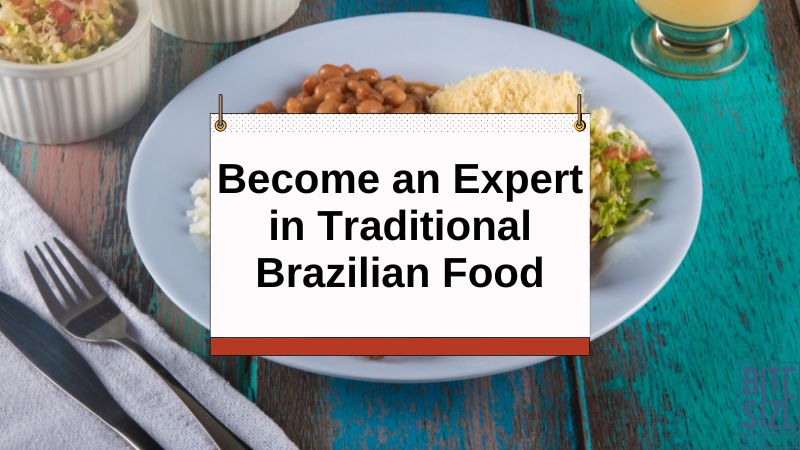
[…] And I know you haven’t thought about it, but I consider food culture to be culture as well. […]